Gallery
- T3D MC 256 at the EPFL
- T3D MC 256 Computer
- T3D MC 256 control panel
- MC 256 control panel
- Inside of the T3D MC 256
The T3D (Torus, 3-Dimensional) was Cray Research's first attempt at a massively parallel supercomputer architecture. Launched in 1993, [1] it also marked Cray's first use of another company's microprocessor. The T3D consisted of between 32 and 2048 Processing Elements (PEs), each comprising a 150 MHz DEC Alpha 21064 (EV4) microprocessor and either 16 or 64 MB of DRAM. PEs were grouped in pairs, or nodes, which incorporated a 6-way processor interconnect switch. These switches had a peak bandwidth of 300 MB/second in each direction and were connected to form a three-dimensional torus network topology.
The T3D was designed to be hosted by a Cray Y-MP Model E, M90 or C90-series "front-end" system and rely on it and its UNICOS operating system for all I/O and most system services. The T3D PEs ran a simple microkernel called UNICOS MAX.
Several different configurations of T3D were available. The SC (Single Cabinet) models shared a cabinet with a host Y-MP system and were available with either 128 or 256 PEs. The MC (Multi-Cabinet) models were housed in one or more liquid-cooled cabinet(s) separately from the host, while the MCA models were smaller (32 to 128 PEs) air-cooled multi-cabinet configurations. There was also a liquid-cooled MCN model which had an alternative interconnect wire mat allowing non-power-of-2 numbers of PEs.
The Cray T3D MC cabinet had an Apple Macintosh PowerBook laptop built into its front. Its only purpose was to display animated Cray Research and T3D logos on its color LCD screen.
The first T3D delivered was a prototype installed at the Pittsburgh Supercomputing Center in early September 1993. The supercomputer was formally introduced on 27 September 1993.[ citation needed ]
The T3D was superseded in 1995 by the faster and more sophisticated Cray T3E.

A supercomputer is a computer with a high level of performance as compared to a general-purpose computer. The performance of a supercomputer is commonly measured in floating-point operations per second (FLOPS) instead of million instructions per second (MIPS). Since 2017, supercomputers have existed which can perform over 1017 FLOPS (a hundred quadrillion FLOPS, 100 petaFLOPS or 100 PFLOPS). For comparison, a desktop computer has performance in the range of hundreds of gigaFLOPS (1011) to tens of teraFLOPS (1013). Since November 2017, all of the world's fastest 500 supercomputers run on Linux-based operating systems. Additional research is being conducted in the United States, the European Union, Taiwan, Japan, and China to build faster, more powerful and technologically superior exascale supercomputers.
UNICOS is a range of Unix and after it Linux operating system (OS) variants developed by Cray for its supercomputers. UNICOS is the successor of the Cray Operating System (COS). It provides network clustering and source code compatibility layers for some other Unixes. UNICOS was originally introduced in 1985 with the Cray-2 system and later ported to other Cray models. The original UNICOS was based on UNIX System V Release 2, and had many Berkeley Software Distribution (BSD) features added to it.
Cray Inc., a subsidiary of Hewlett Packard Enterprise, is an American supercomputer manufacturer headquartered in Seattle, Washington. It also manufactures systems for data storage and analytics. Several Cray supercomputer systems are listed in the TOP500, which ranks the most powerful supercomputers in the world.

Quadrics was a supercomputer company formed in 1996 as a joint venture between Alenia Spazio and the technical team from Meiko Scientific. They produced hardware and software for clustering commodity computer systems into massively parallel systems. Their highpoint was in June 2003 when six out of the ten fastest supercomputers in the world were based on Quadrics' interconnect. They officially closed on June 29, 2009.

The Cray X-MP was a supercomputer designed, built and sold by Cray Research. It was announced in 1982 as the "cleaned up" successor to the 1975 Cray-1, and was the world's fastest computer from 1983 to 1985 with a quad-processor system performance of 800 MFLOPS. The principal designer was Steve Chen.

The Cray Y-MP was a supercomputer sold by Cray Research from 1988, and the successor to the company's X-MP. The Y-MP retained software compatibility with the X-MP, but extended the address registers from 24 to 32 bits. High-density VLSI ECL technology was used and a new liquid-cooling system was devised. The Y-MP ran the Cray UNICOS operating system.
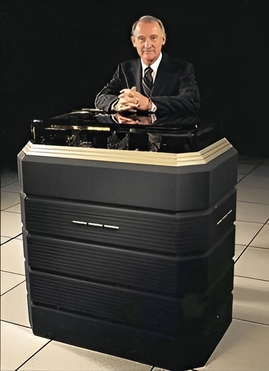
The Cray-3 was a vector supercomputer, Seymour Cray's designated successor to the Cray-2. The system was one of the first major applications of gallium arsenide (GaAs) semiconductors in computing, using hundreds of custom built ICs packed into a 1 cubic foot (0.028 m3) CPU. The design goal was performance around 16 GFLOPS, about 12 times that of the Cray-2.

The Cray T3E was Cray Research's second-generation massively parallel supercomputer architecture, launched in late November 1995. The first T3E was installed at the Pittsburgh Supercomputing Center in 1996. Like the previous Cray T3D, it was a fully distributed memory machine using a 3D torus topology interconnection network. The T3E initially used the DEC Alpha 21164 (EV5) microprocessor and was designed to scale from 8 to 2,176 Processing Elements (PEs). Each PE had between 64 MB and 2 GB of DRAM and a 6-way interconnect router with a payload bandwidth of 480 MB/s in each direction. Unlike many other MPP systems, including the T3D, the T3E was fully self-hosted and ran the UNICOS/mk distributed operating system with a GigaRing I/O subsystem integrated into the torus for network, disk and tape I/O.

The Cray C90 series was a vector processor supercomputer launched by Cray Research in 1991. The C90 was a development of the Cray Y-MP architecture. Compared to the Y-MP, the C90 processor had a dual vector pipeline and a faster 4.1 ns clock cycle (244 MHz), which together gave three times the performance of the Y-MP processor. The maximum number of processors in a system was also doubled from eight to 16. The C90 series used the same Model E IOS and UNICOS operating system as the earlier Y-MP Model E.
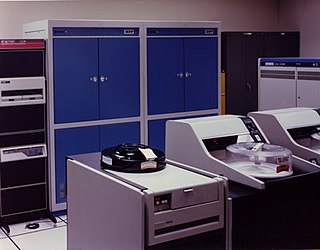
The Goodyear Massively Parallel Processor (MPP) was a massively parallel processing supercomputer built by Goodyear Aerospace for the NASA Goddard Space Flight Center. It was designed to deliver enormous computational power at lower cost than other existing supercomputer architectures, by using thousands of simple processing elements, rather than one or a few highly complex CPUs. Development of the MPP began circa 1979; it was delivered in May 1983, and was in general use from 1985 until 1991.

The Arctic Region Supercomputing Center (ARSC) was from 1993 to 2015 a research facility organized under the University of Alaska Fairbanks (UAF). Located on the UAF campus, ARSC offered high-performance computing (HPC) and mass storage to the UAF and State of Alaska research communities.
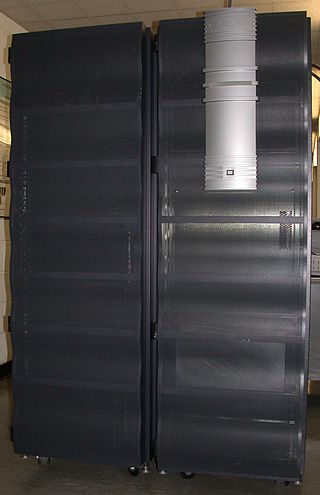
The Cray J90 series was an air-cooled vector processor supercomputer first sold by Cray Research in 1994. The J90 evolved from the Cray Y-MP EL minisupercomputer, and is compatible with Y-MP software, running the same UNICOS operating system. The J90 supported up to 32 CMOS processors with a 10 ns clock. It supported up to 4 GB of main memory and up to 48 GB/s of memory bandwidth, giving it considerably less performance than the contemporary Cray T90, but making it a strong competitor to other technical computers in its price range. All input/output in a J90 system was handled by an IOS called IOS Model V. The IOS-V was based on the VME64 bus and SPARC I/O processors (IOPs) running the VxWorks RTOS. The IOS was programmed to emulate the IOS Model E, used in the larger Cray Y-MP systems, in order to minimize changes in the UNICOS operating system. By using standard VME boards, a wide variety of commodity peripherals could be used.
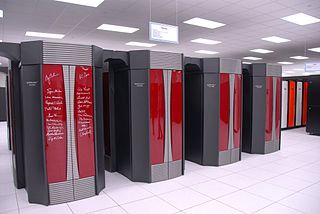
The Cray X1 is a non-uniform memory access, vector processor supercomputer manufactured and sold by Cray Inc. since 2003. The X1 is often described as the unification of the Cray T90, Cray SV1, and Cray T3E architectures into a single machine. The X1 shares the multistreaming processors, vector caches, and CMOS design of the SV1, the highly scalable distributed memory design of the T3E, and the high memory bandwidth and liquid cooling of the T90.

The Cray XT3 is a distributed memory massively parallel MIMD supercomputer designed by Cray Inc. with Sandia National Laboratories under the codename Red Storm. Cray turned the design into a commercial product in 2004. The XT3 derives much of its architecture from the previous Cray T3E system, and also from the Intel ASCI Red supercomputer.

The Cray EL90 series was an air-cooled vector processor supercomputer first sold by Cray Research in 1993. The EL90 series evolved from the Cray Y-MP EL minisupercomputer, and is compatible with Y-MP software, running the same UNICOS operating system. The range comprised three models:

The Cray XT5 is an updated version of the Cray XT4 supercomputer, launched on November 6, 2007. It includes a faster version of the XT4's SeaStar2 interconnect router called SeaStar2+, and can be configured either with XT4 compute blades, which have four dual-core AMD Opteron processor sockets, or XT5 blades, with eight sockets supporting dual or quad-core Opterons. The XT5 uses a 3-dimensional torus network topology.
The Challenge, code-named Eveready and Terminator, is a family of server computers and supercomputers developed and manufactured by Silicon Graphics in the early to mid-1990s that succeeded the earlier Power Series systems. The Challenge was later succeeded by the NUMAlink-based Origin 200 and Origin 2000 in 1996.
The Cray CX1 is a deskside workstation designed by Cray Inc., based on the x86-64 processor architecture. It was launched on September 16, 2008, and was discontinued in early 2012. It comprises a single chassis blade server design that supports a maximum of eight modular single-width blades, giving up to 96 processor cores. Computational load can be run independently on each blade and/or combined using clustering techniques.
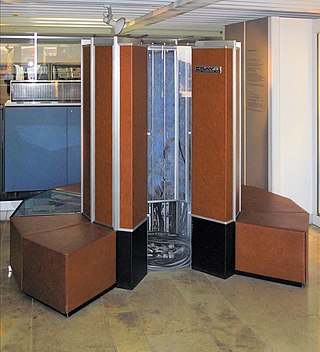
The history of supercomputing goes back to the 1960s when a series of computers at Control Data Corporation (CDC) were designed by Seymour Cray to use innovative designs and parallelism to achieve superior computational peak performance. The CDC 6600, released in 1964, is generally considered the first supercomputer. However, some earlier computers were considered supercomputers for their day such as the 1954 IBM NORC in the 1950s, and in the early 1960s, the UNIVAC LARC (1960), the IBM 7030 Stretch (1962), and the Manchester Atlas (1962), all of which were of comparable power.
SHMEM is a family of parallel programming libraries, providing one-sided, RDMA, parallel-processing interfaces for low-latency distributed-memory supercomputers. The SHMEM acronym was subsequently reverse engineered to mean "Symmetric Hierarchical MEMory”. Later it was expanded to distributed memory parallel computer clusters, and is used as parallel programming interface or as low-level interface to build partitioned global address space (PGAS) systems and languages. “Libsma”, the first SHMEM library, was created by Richard Smith at Cray Research in 1993 as a set of thin interfaces to access the CRAY T3D's inter-processor-communication hardware. SHMEM has been implemented by Cray Research, SGI, Cray Inc., Quadrics, HP, GSHMEM, IBM, QLogic, Mellanox, Universities of Houston and Florida; there is also open-source OpenSHMEM.